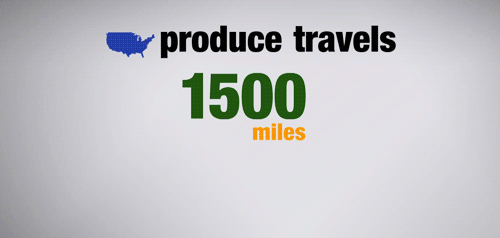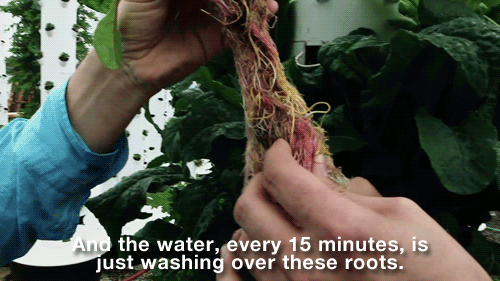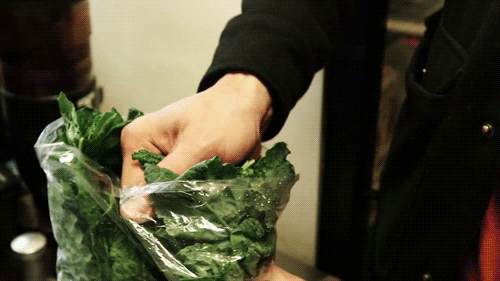Vertical, aeroponic farming gives soil a run for its money
In the United States, produce can travel up to 1500 miles before reaching its final destination. With more than 80 percent of the world's farmable land already in use, farmers and scientists are aggressively exploring alternatives for continuing to supply the world's food. Estimates show that another 3 billion people may exist on Earth by 2050.

One solution to providing nutrition for all those people: Instead of farming out, how about farming up?
"Aeroponic farming"—also known as “vertical farming”—is a plant growth process conducted in an air- or mist-based environment, done entirely without using soil. One company’s product, Tower Gardens, has almost become synonymous with the approach.
Engineer and "TechKnow" contributor Kosta Grammatis travels from a small commercial farm in Summerland, Calif., to Chicago’s O'Hare Airport—which has installed the first aeroponic garden in any airport in the world. Kosta even hits up a pre-school where kids both grow and learn about vertical farms.
At Summerland’s Montecito Urban Farms, owner Alex Thomson introduces Kosta to the ins and outs of his aeroponic farming business.
Thomson originally had Tower Gardens on the balcony at his home and began sharing his fresh produce with a local eatery. Inspired by Thomson's ability to grow quality produce in a space as small as his balcony, Cafe Luna looked into installing Tower Gardens on their rooftop. They weren't able to secure the permits for the vertical farm, but Thomson recognized the opportunity to expand his own work. He found a parking lot and set up rows of Tower Gardens to create the vertical farm that eventually became Montecito Urban Farms.
To better understand how an unused parking lot could be ideal for housing a farm, Thomson shows Kosta exactly how each Tower Garden works.

(To see a step-by-step version of how to use an aeroponic system, read "How Aeroponic Vertical Farming Works.")
Water filters up through the center column of the tower and constantly washes each plant's root systems, giving them the nutrients and oxidation needed to grow healthy, flavorful herbs, greens, and root vegetables.

Within one year of operation, Thomson has already secured business with three local restaurants, and he says more deals are on the way. His first client, Cafe Luna, is only 50 feet away from Montecito Urban Farms.
Cafe Luna regularly receives herbs and vegetables from Thomson's farm and incorporates them into their dishes. Owner Dan Van Hirtum says they increased their customer base after switching to fresh ingredients.
"Absolutely, yes," Van Nirtum says. "[Customers] are saying that things pop. They taste just fabulous."
Cafe Luna's kale and spinach smoothie is a favorite among the restaurant's regulars. Kosta even helps make the popular smoothie using freshly picked greens from Montecito.

Combine all ingredients. Blend until smooth. Voila!

Summerland may be on the road to their own "locavore" food revolution, but vertical farming isn't only making an impact in smaller towns.
Chicago O'Hare International Airport has made an effort to introduce travelers from all over the world the fresh tastes of locally grown and harvested produce.
All ticketed travelers can visit the aeroponic garden inside Terminal 3, so Kosta goes to track it down. The garden sits in a previously empty corridor in Concourse G, and each of the towers are flush with vibrant greens and vegetables.

Installed in 2011, the Chicago O'Hare Aeroponic Garden provides a long list of freshly grown foods to a number of the restaurants scattered throughout the airport.
Kosta picks fresh greens from the garden, and then walks over to Wicker Park Sushi to have their staff prepare rolls with the leafy greens.
Wicker Park Sushi's manager Brad Maher tells Kosta that using the airport's urban garden has become part of their daily routine. "What we'll do is we'll go through the garden, and we'll select what needs to be harvested for the day,” he says. “We'll have our farm in there, and he'll harvest whatever the restaurants are calling for."
Kosta gets a chance to taste Wicker Park's chicken teriyaki roll and experiences the flavor of some of the airport garden's lettuces and chives.
The fact that Tower Gardens don't take up much space also allows them to be ideal resources in the classroom.
In Santa Barbara, Calif., Hope 4 Kids Preschool has set up a few Tower Gardens to fill out the school's nutritious snack menu—and to educate the students about how to grow and ask questions about the food they eat.
Parents have definitely noticed the difference. One mom says, "One day we're at the supermarket -- and this is after the Tower Gardens appeared -- she grabbed a sugar pea and started eating it. I thought, 'Wow. I can't believe she's doing this.'"
Cheri Diaz, the director at Hope 4 Kids, says giving children hands-on knowledge about food and farming so young could potentially change the food industry on a national scale.
"I believe it would seriously shut down the fast food industry as we know it, because people would learn the value of eating healthy," she says. It would also help make learning easier for students. "Because you can't learn if you can't think, and you can't think if you're not healthy."
What do you think? Could vertical farming change the entire way the world thinks about and accesses food?
Error
Sorry, your comment was not saved due to a technical problem. Please try again later or using a different browser.